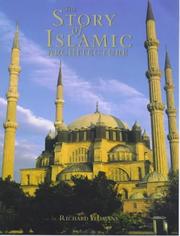| Listing 1 - 4 of 4 |
Sort by
|

ISBN: 1859641083 Year: 1999 Publisher: Reading Garnet
Abstract | Keywords | Export | Availability | Bookmark
 Loading...
Loading...Choose an application
- Reference Manager
- EndNote
- RefWorks (Direct export to RefWorks)
There is perhaps no better place to observe how a living faith like Islam functions in its architectural setting than in the Great Mosque at Damascus. It is also the most appropriate place to begin a history of Islamic architecture since it was built in 715 and is the oldest congregational mosque in the Muslim world. Despite its antiquity, Richard Yeomans believes that the activity observed in the mosque today bears witness to an extraordinary continuity of worship and social behaviour reaching back nearly 1400 years to the Prophet Muhammad's own mosque in Medina. Using a broad historical narrative to explain the religious, social and political influences that shape the Islamic architectural form, "The Story of Islamic Architecture" reveals an architectural splendour that despite its diversity has coherence and continuity. Beginning with a brief description of the Muslim faith, the introductory chapters of this book illustrate how religious attitudes determine the form and function of Islamic art and architecture. The book then considers the genesis of a distinctly Islamic architecture from the first monuments when the Umayyad Caliphate, bringing with it political and mercantile acumen but scarce architectural knowledge, was totally dependent on the art, craft and building skills of the indigenous population in the countries it had conquered. These early monuments illustrate how the story of Islamic architecture is one of continuing adaptation, change and innovation in response to the complex cultural and racial diversity which constitutes the Muslim nation. The book then charts the gradual evolution and eventual emergence of a distinctive Arab identity in ninth-century Iraq, Tunisia and Egypt
Islamic architecture --- Arab architecture --- Architecture, Arab --- Architecture, Islamic --- Architecture, Moorish --- Architecture, Muslim --- Architecture, Saracenic --- Moorish architecture --- Muslim architecture --- Saracenic architecture --- Religious architecture --- Islam --- Architecture
Periodical
ISSN: 20862636 23564644 Year: 2010
Abstract | Keywords | Export | Availability | Bookmark
 Loading...
Loading...Choose an application
- Reference Manager
- EndNote
- RefWorks (Direct export to RefWorks)
Islamic architecture --- Islamic architecture. --- Architecture islamique --- Periodicals --- Périodiques --- mosque architecture --- art and culture --- architectural history --- Islamic architecture --- Arab architecture --- Architecture, Arab --- Architecture, Islamic --- Architecture, Moorish --- Architecture, Muslim --- Architecture, Saracenic --- Moorish architecture --- Muslim architecture --- Saracenic architecture --- Religious architecture --- Islam
Book
ISBN: 3829025572 9783829025577 Year: 2000 Publisher: Keulen Könemann
Abstract | Keywords | Export | Availability | Bookmark
 Loading...
Loading...Choose an application
- Reference Manager
- EndNote
- RefWorks (Direct export to RefWorks)
Islam --- architecture [discipline] --- Architecture --- Islamic [culture or style] --- architectural history --- islamitische kunst --- art history --- decorative arts --- illuminated manuscripts --- Islamic World, The --- kunst --- islamitische architectuur --- History of civilization --- Applied arts. Arts and crafts --- Islamitische kunst ; geschiedenis --- Islamitische architectuur --- #gsdbA --- 7.033.3 --- 72.033.3 --- islam --- architectuur --- geschiedenis --- cultuur --- 7.033 --- Islamitische, Arabische kunst van de Middeleeuwen --- Islamarchitectuur --- Islam (architectuur) --- Islamkunst --- Islamitische kunst --- kunst - middeleeuwen (incl. Byzantijnse, christelijke en islamitische kunst) --- Islamic art. --- Architecture, Islamic. --- Islamic civilization. --- 7.033.3 Islamitische, Arabische kunst van de Middeleeuwen --- #GGSB: Islam --- #GGSB: Kunst --- decorative arts [discipline] --- Kunst --- architectuur, klassieke oudheid
Periodical
Abstract | Keywords | Export | Availability | Bookmark
 Loading...
Loading...Choose an application
- Reference Manager
- EndNote
- RefWorks (Direct export to RefWorks)
Islamic architecture --- Vernacular architecture --- Building --- Architecture islamique --- Architecture vernaculaire --- Construction --- Building. --- Islamic architecture. --- Vernacular architecture. --- Architectural engineering --- Buildings --- Construction science --- Engineering, Architectural --- Structural design --- Structural engineering --- Architecture --- Construction industry --- Architecture, Anonymous --- Architecture, Indigenous --- Architecture, Vernacular --- Folk architecture --- Indigenous architecture --- Traditional architecture --- Arab architecture --- Architecture, Arab --- Architecture, Islamic --- Architecture, Moorish --- Architecture, Muslim --- Architecture, Saracenic --- Moorish architecture --- Muslim architecture --- Saracenic architecture --- Religious architecture --- Design and construction --- Developing countries. --- Islamic countries. --- Muslim countries --- Emerging nations --- Fourth World --- Global South --- LDC's --- Least developed countries --- Less developed countries --- Newly industrialized countries --- Newly industrializing countries --- NICs --- Third World --- Underdeveloped areas --- Underdeveloped countries --- 72
| Listing 1 - 4 of 4 |
Sort by
|

 Search
Search Feedback
Feedback About UniCat
About UniCat  Help
Help News
News